2015 DODGE CHARGER octane
[x] Cancel search: octanePage 466 of 638
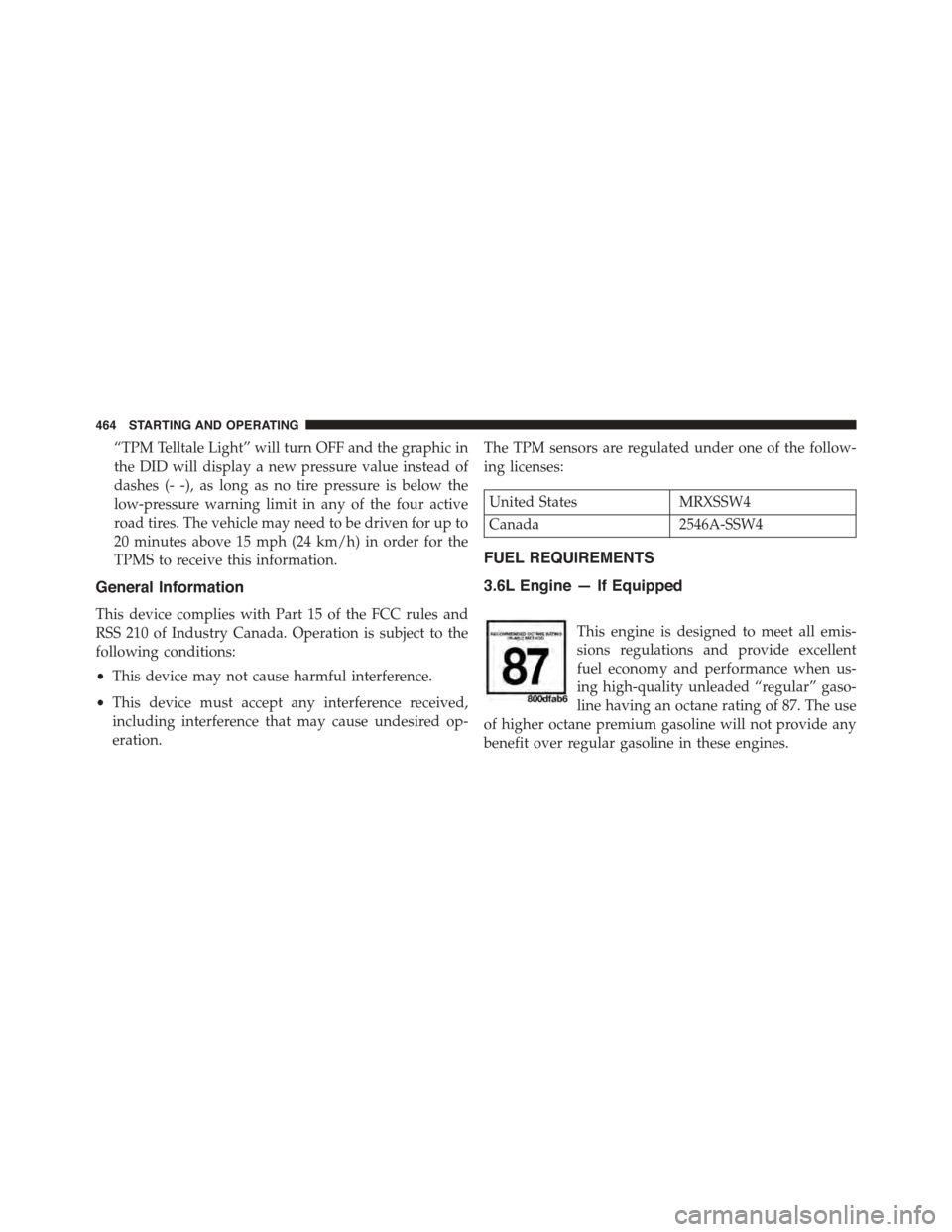
“TPM Telltale Light” will turn OFF and the graphic in
the DID will display a new pressure value instead of
dashes (- -), as long as no tire pressure is below the
low-pressure warning limit in any of the four active
road tires. The vehicle may need to be driven for up to
20 minutes above 15 mph (24 km/h) in order for the
TPMS to receive this information.
General Information
This device complies with Part 15 of the FCC rules and
RSS 210 of Industry Canada. Operation is subject to the
following conditions:
•This device may not cause harmful interference.
•This device must accept any interference received,
including interference that may cause undesired op-
eration.
The TPM sensors are regulated under one of the follow-
ing licenses:
United StatesMRXSSW4
Canada2546A-SSW4
FUEL REQUIREMENTS
3.6L Engine — If Equipped
This engine is designed to meet all emis-
sions regulations and provide excellent
fuel economy and performance when us-
ing high-quality unleaded “regular” gaso-
line having an octane rating of 87. The use
of higher octane premium gasoline will not provide any
benefit over regular gasoline in these engines.
464 STARTING AND OPERATING
Page 467 of 638
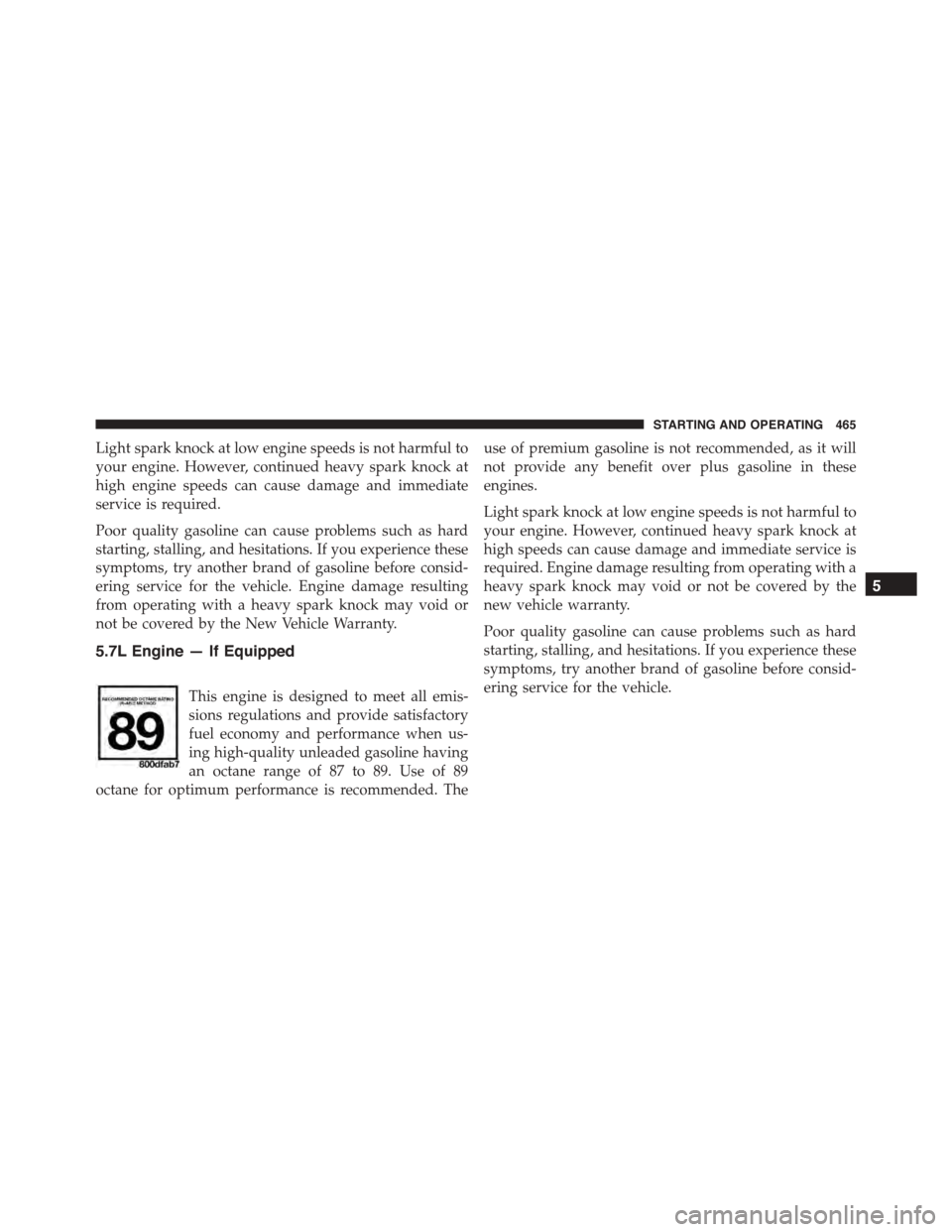
Light spark knock at low engine speeds is not harmful to
your engine. However, continued heavy spark knock at
high engine speeds can cause damage and immediate
service is required.
Poor quality gasoline can cause problems such as hard
starting, stalling, and hesitations. If you experience these
symptoms, try another brand of gasoline before consid-
ering service for the vehicle. Engine damage resulting
from operating with a heavy spark knock may void or
not be covered by the New Vehicle Warranty.
5.7L Engine — If Equipped
This engine is designed to meet all emis-
sions regulations and provide satisfactory
fuel economy and performance when us-
ing high-quality unleaded gasoline having
an octane range of 87 to 89. Use of 89
octane for optimum performance is recommended. The
use of premium gasoline is not recommended, as it will
not provide any benefit over plus gasoline in these
engines.
Light spark knock at low engine speeds is not harmful to
your engine. However, continued heavy spark knock at
high speeds can cause damage and immediate service is
required. Engine damage resulting from operating with a
heavy spark knock may void or not be covered by the
new vehicle warranty.
Poor quality gasoline can cause problems such as hard
starting, stalling, and hesitations. If you experience these
symptoms, try another brand of gasoline before consid-
ering service for the vehicle.
5
STARTING AND OPERATING 465
Page 469 of 638
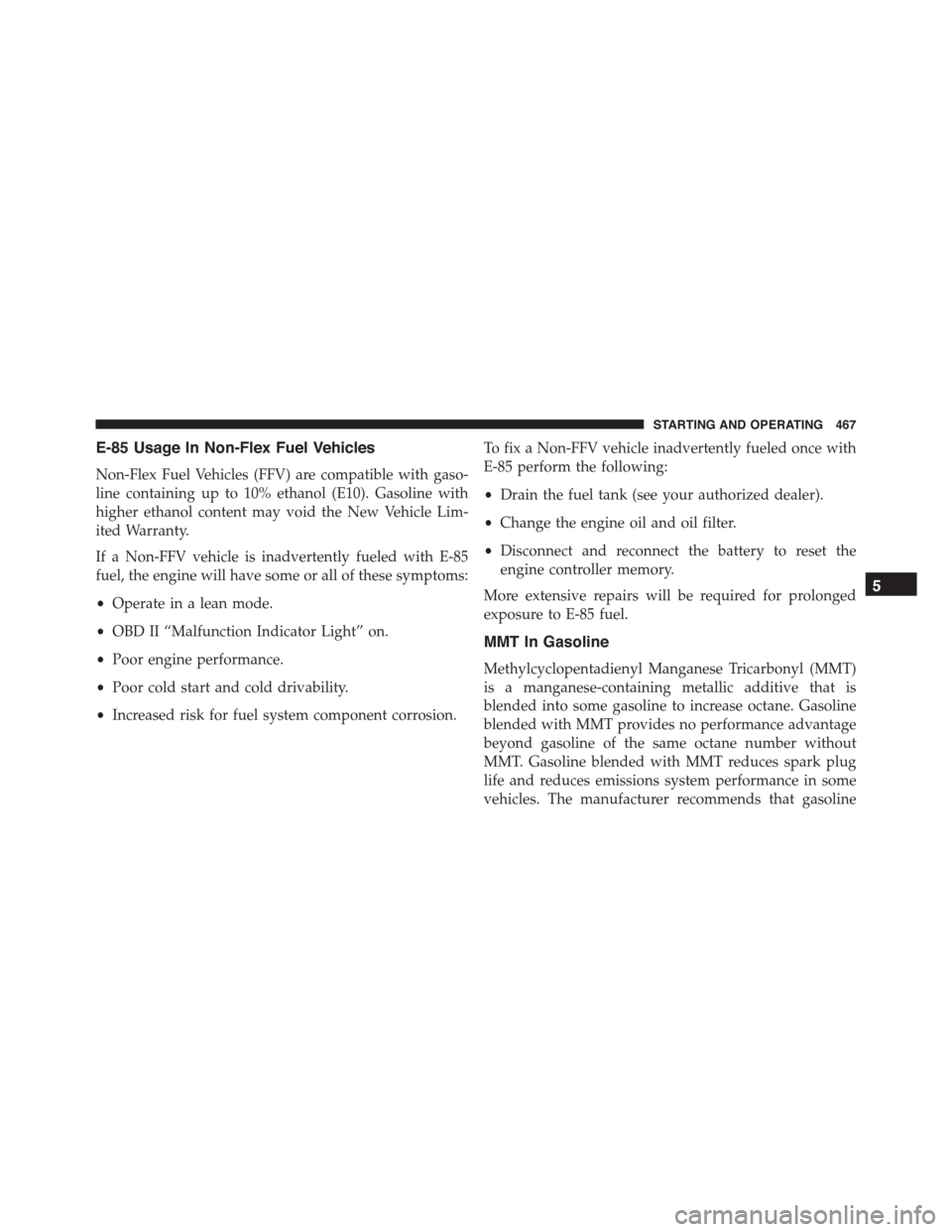
E-85 Usage In Non-Flex Fuel Vehicles
Non-Flex Fuel Vehicles (FFV) are compatible with gaso-
line containing up to 10% ethanol (E10). Gasoline with
higher ethanol content may void the New Vehicle Lim-
ited Warranty.
If a Non-FFV vehicle is inadvertently fueled with E-85
fuel, the engine will have some or all of these symptoms:
•Operate in a lean mode.
•OBD II “Malfunction Indicator Light” on.
•Poor engine performance.
•Poor cold start and cold drivability.
•Increased risk for fuel system component corrosion.
To fix a Non-FFV vehicle inadvertently fueled once with
E-85 perform the following:
•Drain the fuel tank (see your authorized dealer).
•Change the engine oil and oil filter.
•Disconnect and reconnect the battery to reset the
engine controller memory.
More extensive repairs will be required for prolonged
exposure to E-85 fuel.
MMT In Gasoline
Methylcyclopentadienyl Manganese Tricarbonyl (MMT)
is a manganese-containing metallic additive that is
blended into some gasoline to increase octane. Gasoline
blended with MMT provides no performance advantage
beyond gasoline of the same octane number without
MMT. Gasoline blended with MMT reduces spark plug
life and reduces emissions system performance in some
vehicles. The manufacturer recommends that gasoline
5
STARTING AND OPERATING 467
Page 471 of 638
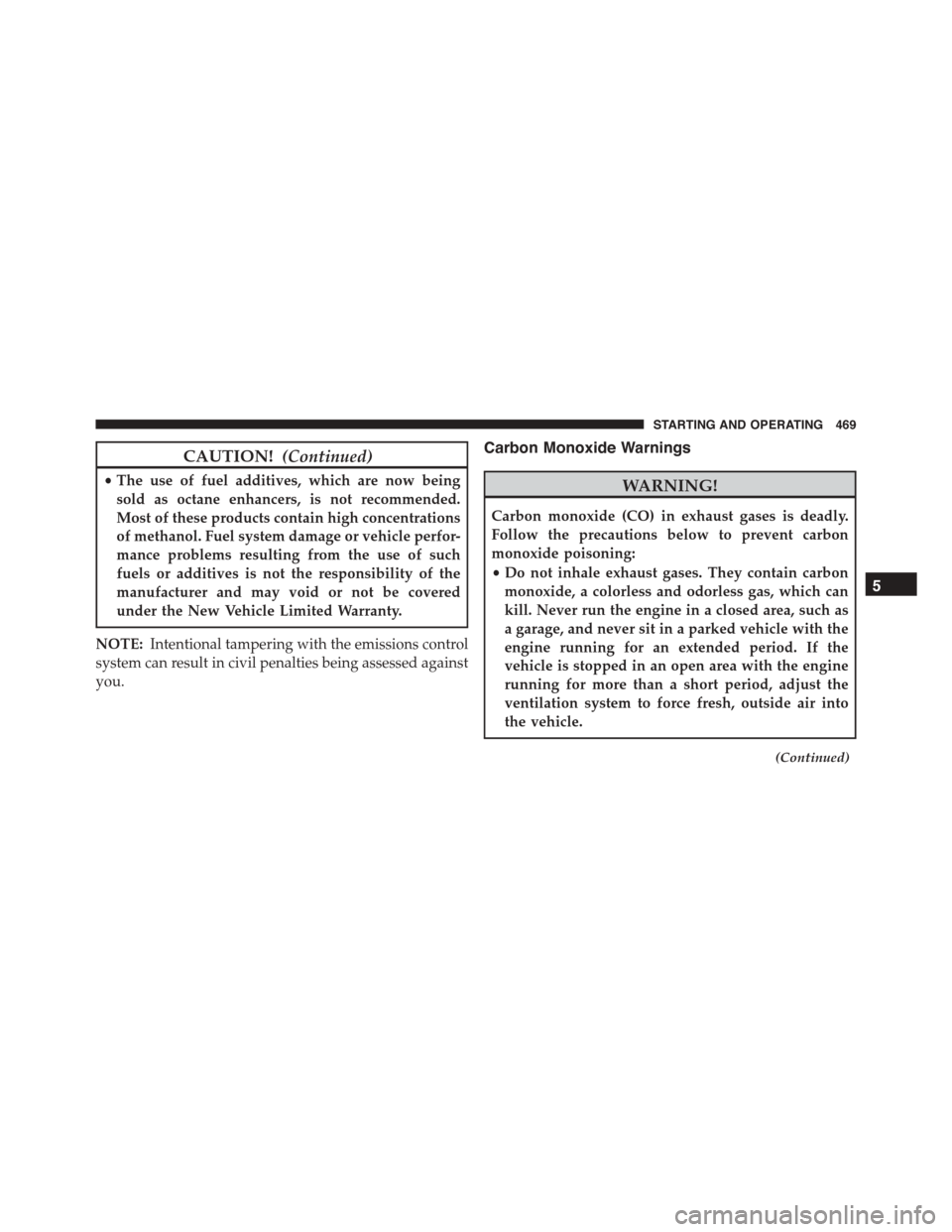
CAUTION!(Continued)
•The use of fuel additives, which are now being
sold as octane enhancers, is not recommended.
Most of these products contain high concentrations
of methanol. Fuel system damage or vehicle perfor-
mance problems resulting from the use of such
fuels or additives is not the responsibility of the
manufacturer and may void or not be covered
under the New Vehicle Limited Warranty.
NOTE:Intentional tampering with the emissions control
system can result in civil penalties being assessed against
you.
Carbon Monoxide Warnings
WARNING!
Carbon monoxide (CO) in exhaust gases is deadly.
Follow the precautions below to prevent carbon
monoxide poisoning:
•Do not inhale exhaust gases. They contain carbon
monoxide, a colorless and odorless gas, which can
kill. Never run the engine in a closed area, such as
a garage, and never sit in a parked vehicle with the
engine running for an extended period. If the
vehicle is stopped in an open area with the engine
running for more than a short period, adjust the
ventilation system to force fresh, outside air into
the vehicle.
(Continued)
5
STARTING AND OPERATING 469
Page 473 of 638
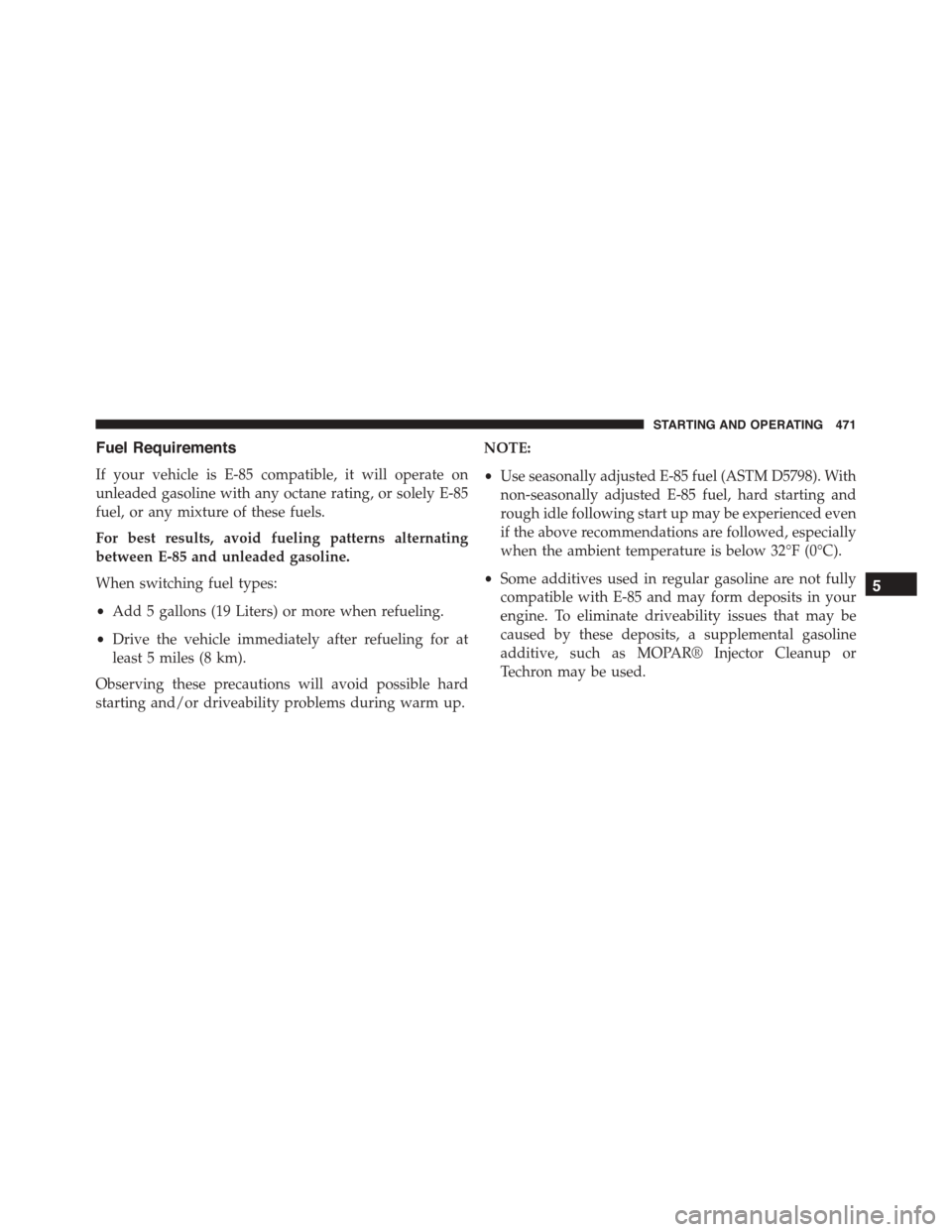
Fuel Requirements
If your vehicle is E-85 compatible, it will operate on
unleaded gasoline with any octane rating, or solely E-85
fuel, or any mixture of these fuels.
For best results, avoid fueling patterns alternating
between E-85 and unleaded gasoline.
When switching fuel types:
•Add 5 gallons (19 Liters) or more when refueling.
•Drive the vehicle immediately after refueling for at
least 5 miles (8 km).
Observing these precautions will avoid possible hard
starting and/or driveability problems during warm up.
NOTE:
•Use seasonally adjusted E-85 fuel (ASTM D5798). With
non-seasonally adjusted E-85 fuel, hard starting and
rough idle following start up may be experienced even
if the above recommendations are followed, especially
when the ambient temperature is below 32°F (0°C).
•Some additives used in regular gasoline are not fully
compatible with E-85 and may form deposits in your
engine. To eliminate driveability issues that may be
caused by these deposits, a supplemental gasoline
additive, such as MOPAR® Injector Cleanup or
Techron may be used.
5
STARTING AND OPERATING 471
Page 593 of 638
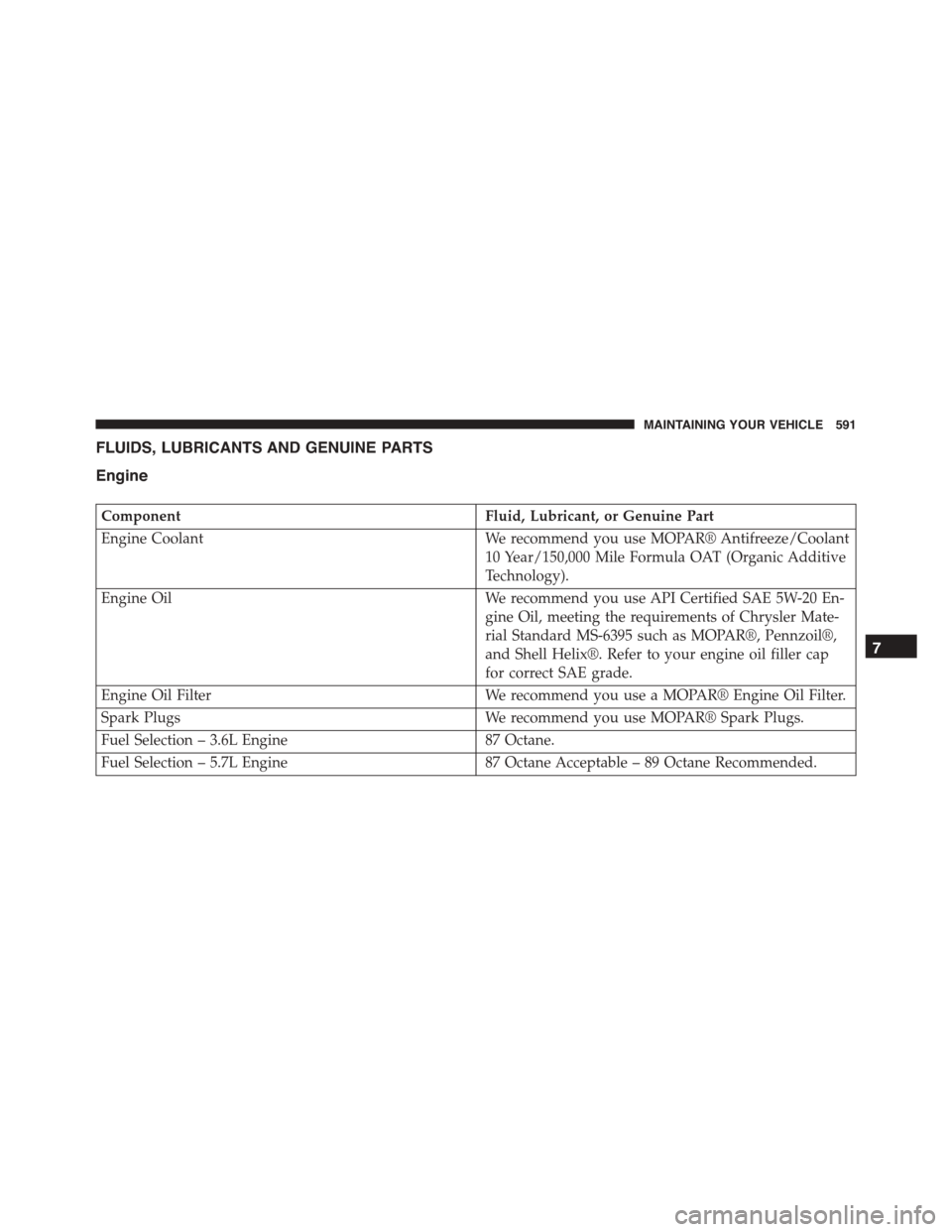
FLUIDS, LUBRICANTS AND GENUINE PARTS
Engine
ComponentFluid, Lubricant, or Genuine Part
Engine CoolantWe recommend you use MOPAR® Antifreeze/Coolant
10 Year/150,000 Mile Formula OAT (Organic Additive
Technology).
Engine OilWe recommend you use API Certified SAE 5W-20 En-
gine Oil, meeting the requirements of Chrysler Mate-
rial Standard MS-6395 such as MOPAR®, Pennzoil®,
and Shell Helix®. Refer to your engine oil filler cap
for correct SAE grade.
Engine Oil FilterWe recommend you use a MOPAR® Engine Oil Filter.
Spark PlugsWe recommend you use MOPAR® Spark Plugs.
Fuel Selection – 3.6L Engine87 Octane.
Fuel Selection – 5.7L Engine87 Octane Acceptable – 89 Octane Recommended.
7
MAINTAINING YOUR VEHICLE 591
Page 623 of 638
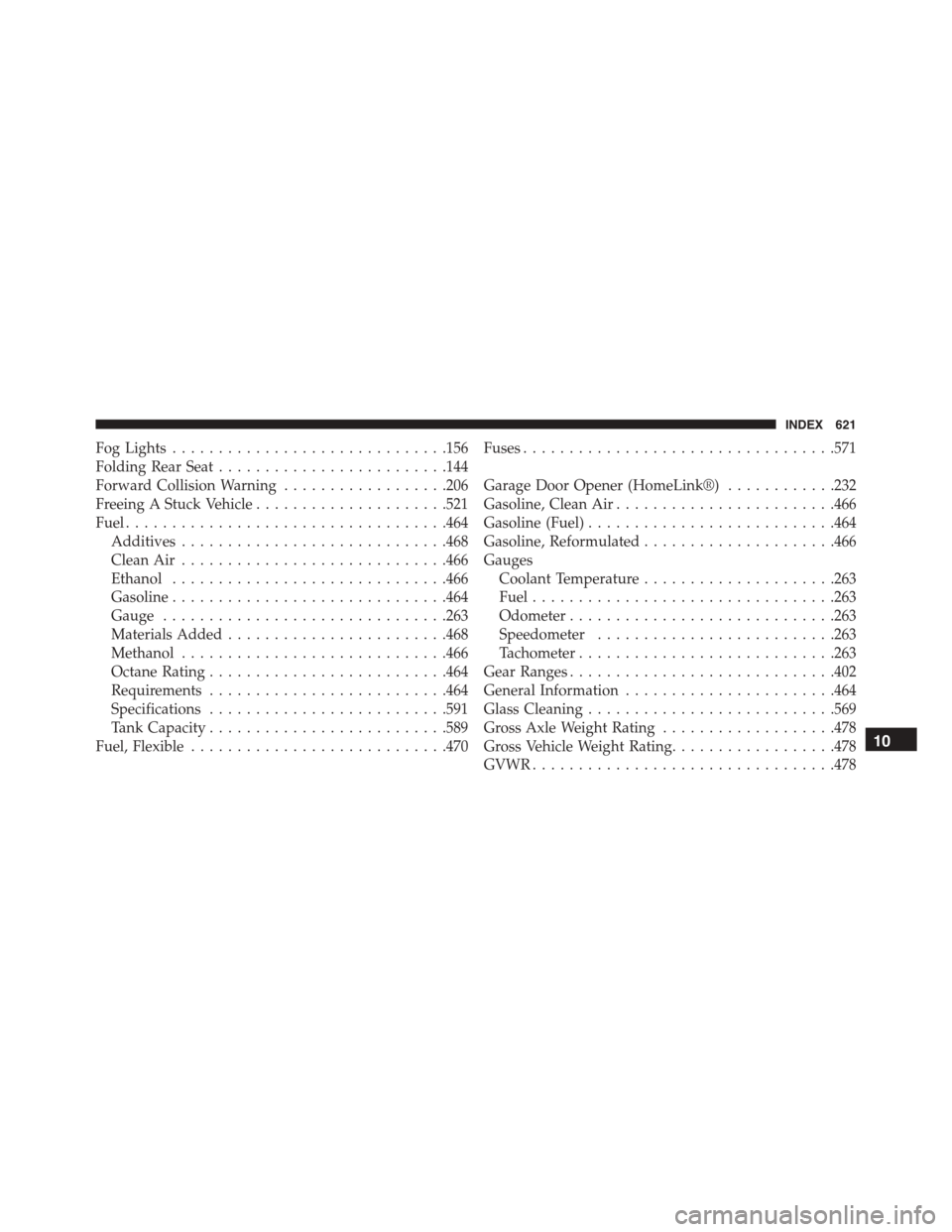
Fog Lights..............................156
Folding Rear Seat.........................144
Forward Collision Warning..................206
Freeing A Stuck Vehicle.....................521
Fuel...................................464
Additives.............................468
Clean Air.............................466
Ethanol..............................466
Gasoline..............................464
Gauge...............................263
Materials Added........................468
Methanol.............................466
Octane Rating..........................464
Requirements..........................464
Specifications..........................591
Tank Capacity..........................589
Fuel, Flexible............................470
Fuses..................................571
Garage Door Opener (HomeLink®)............232
Gasoline, Clean Air........................466
Gasoline (Fuel)...........................464
Gasoline, Reformulated.....................466
Gauges
Coolant Temperature.....................263
Fuel.................................263
Odometer.............................263
Speedometer..........................263
Tachometer............................263
Gear Ranges.............................402
General Information.......................464
Glass Cleaning...........................569
Gross Axle Weight Rating...................478
Gross Vehicle Weight Rating..................478
GVWR.................................478
10
INDEX 621
Page 628 of 638
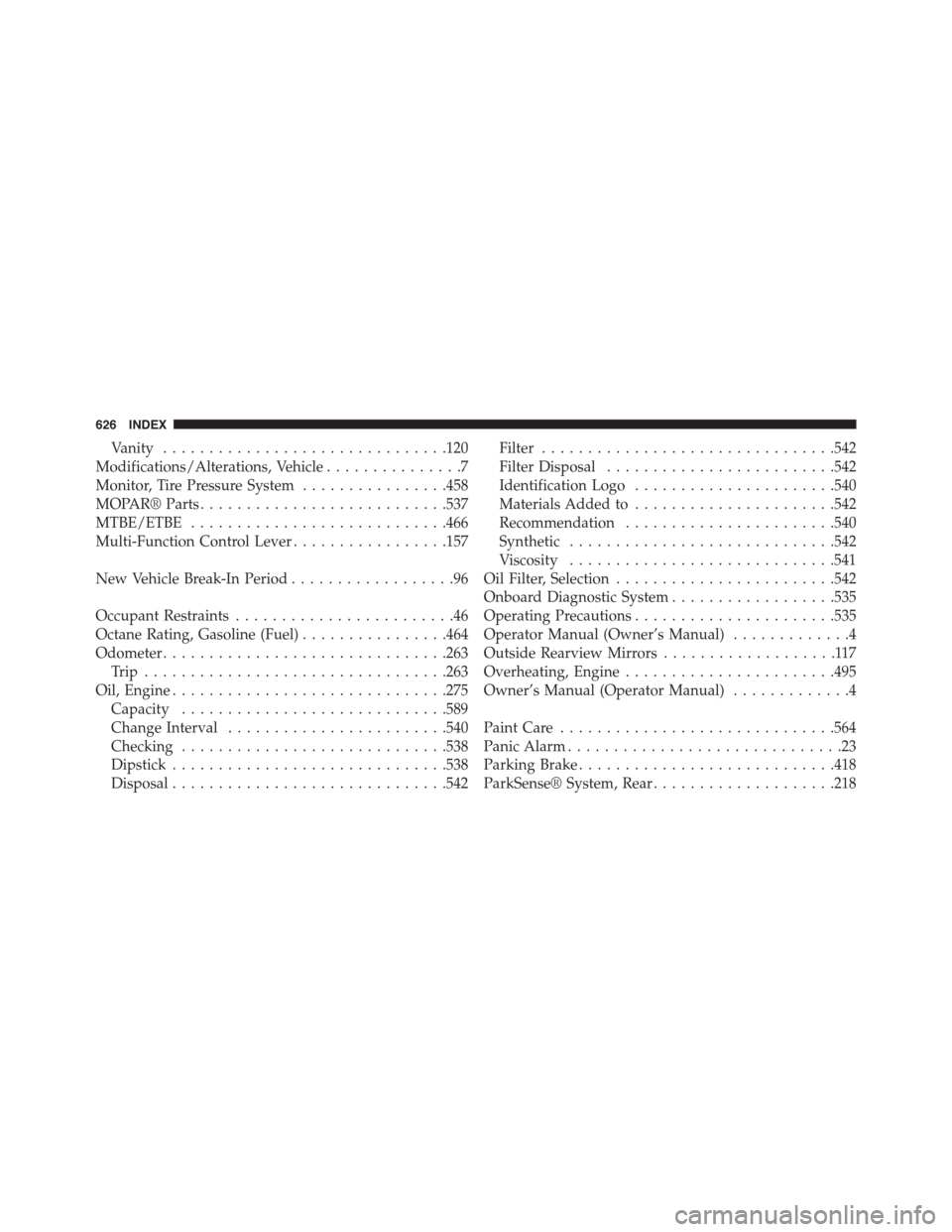
Vanity...............................120
Modifications/Alterations, Vehicle...............7
Monitor, Tire Pressure System................458
MOPAR® Parts...........................537
MTBE/ETBE............................466
Multi-Function Control Lever.................157
New Vehicle Break-In Period..................96
Occupant Restraints........................46
Octane Rating, Gasoline (Fuel)................464
Odometer...............................263
Tr i p . . . . . . . . . . . . . . . . . . . . . . . . . . . . . . . ..263
Oil, Engine..............................275
Capacity.............................589
Change Interval........................540
Checking.............................538
Dipstick..............................538
Disposal..............................542
Filter................................542
Filter Disposal.........................542
Identification Logo......................540
Materials Added to......................542
Recommendation.......................540
Synthetic.............................542
Viscosity.............................541
Oil Filter, Selection........................542
Onboard Diagnostic System..................535
Operating Precautions......................535
Operator Manual (Owner’s Manual).............4
Outside Rearview Mirrors...................117
Overheating, Engine.......................495
Owner’s Manual (Operator Manual).............4
Paint Care..............................564
Panic Alarm..............................23
Parking Brake............................418
ParkSense® System, Rear....................218
626 INDEX